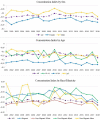Income-related inequalities in diagnosed diabetes prevalence among US adults, 2001-2018
- PMID: 37053158
- PMCID: PMC10101461
- DOI: 10.1371/journal.pone.0283450
Income-related inequalities in diagnosed diabetes prevalence among US adults, 2001-2018
Abstract
Aims: The overall prevalence of diabetes has increased over the past two decades in the United States, disproportionately affecting low-income populations. We aimed to examine the trends in income-related inequalities in diabetes prevalence and to identify the contributions of determining factors.
Methods: We estimated income-related inequalities in diagnosed diabetes during 2001-2018 among US adults aged 18 years or older using data from the National Health Interview Survey (NHIS). The concentration index was used to measure income-related inequalities in diabetes and was decomposed into contributing factors. We then examined temporal changes in diabetes inequality and contributors to those changes over time.
Results: Results showed that income-related inequalities in diabetes, unfavorable to low-income groups, persisted throughout the study period. The income-related inequalities in diabetes decreased during 2001-2011 and then increased during 2011-2018. Decomposition analysis revealed that income, obesity, physical activity levels, and race/ethnicity were important contributors to inequalities in diabetes at almost all time points. Moreover, changes regarding age and income were identified as the main factors explaining changes in diabetes inequalities over time.
Conclusions: Diabetes was more prevalent in low-income populations. Our study contributes to understanding income-related diabetes inequalities and could help facilitate program development to prevent type 2 diabetes and address modifiable factors to reduce diabetes inequalities.
Copyright: This is an open access article, free of all copyright, and may be freely reproduced, distributed, transmitted, modified, built upon, or otherwise used by anyone for any lawful purpose. The work is made available under the Creative Commons CC0 public domain dedication.
Conflict of interest statement
The authors have declared that no competing interests exist.
Figures


References
-
- CDC (Ed.). National diabetes statistics report, 2020. 2020.
-
- Golden SH, Brown A, Cauley JA, Chin MH, Gary-Webb TL, Kim C, et al.. Health Disparities in Endocrine Disorders: Biological, Clinical, and Nonclinical Factors—An Endocrine Society Scientific Statement. The Journal of Clinical Endocrinology & Metabolism 2012;97:E1579–E1639. doi: 10.1210/jc.2012-2043 - DOI - PMC - PubMed
-
- AARP. Beyond 50.09 chronic care: A call to action for health reform. Washington, DC, AARP Public Policy Institute, 2009.
MeSH terms
LinkOut - more resources
Full Text Sources
Medical
Miscellaneous

